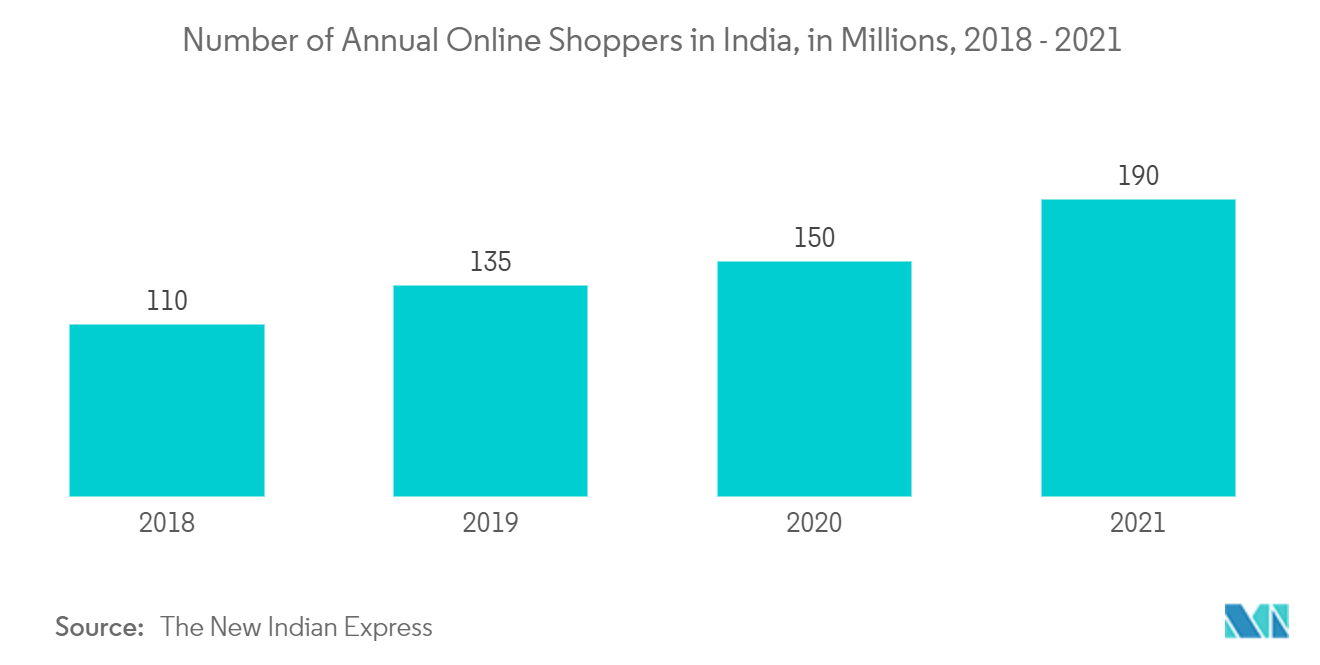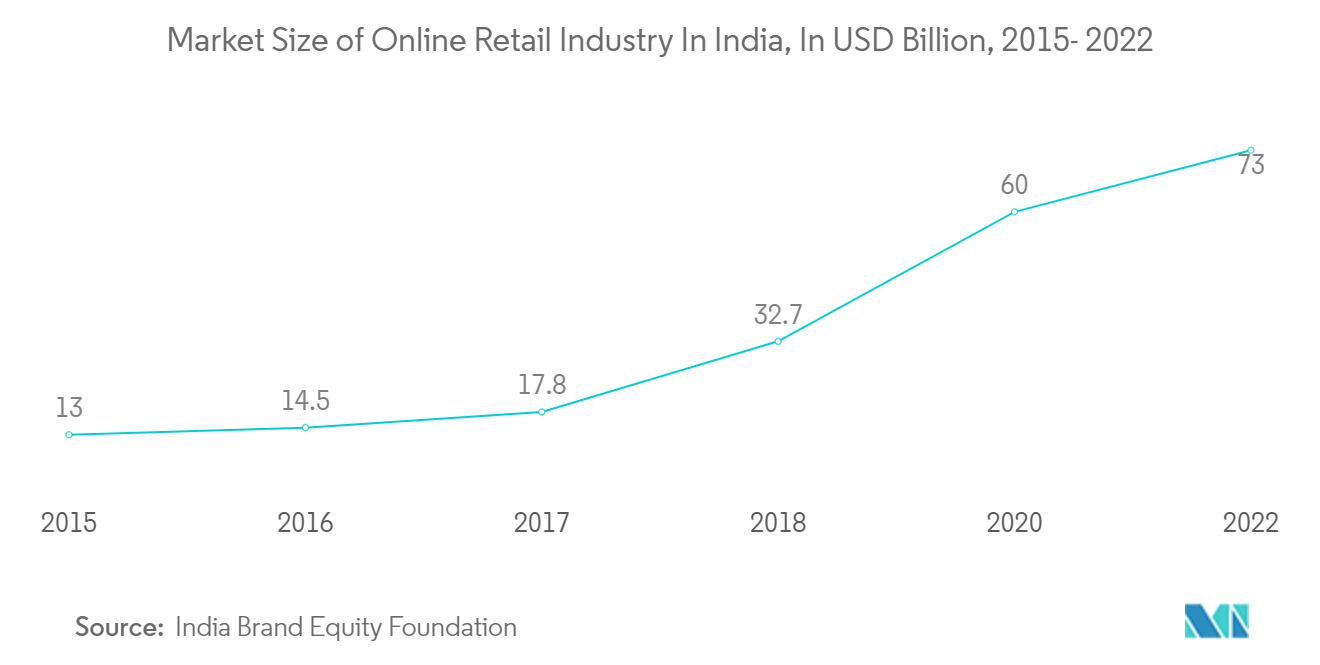Market Trends of India Plastic Packaging Industry
This section covers the major market trends shaping the India Plastic Packaging Market according to our research experts:
Growing E-commerce Industry is Expected to Drive Growth
- Over the past years, the e-commerce industry in India is growing significantly. According to projections, the Indian e-commerce market will increase to USD 200 billion by 2026 from USD 38.5 billion in 2017. Increased internet and smartphone use and the nation's continuing digital transformation are anticipated to fuel this rise. The e-commerce sector briefly fell after India closed down in March 2020, but things started to pick up after the uplifting of restrictions. The number of online orders placed through marketplaces and direct brand websites increased by 130% overall.
- Also, amid the e-commerce boom, one of the fastest-growing sectors is the Indian packaging business, which is expanding rapidly. The Indian Institute of Packaging (IIP) estimates that India's per-person annual packaging usage grew by 200% in the last ten years, from 4.3 kg to 8.6 kg.
- Additionally, during the pandemic, the Indian e-commerce industry witnessed significant growth in online order volume due to the restrictions imposed on the people movement and the shutdown of physical stores. For instance, according to Flipkart, the Indian e-retail market saw a 25% growth in FY21 despite the two-month national lockdown and multiple prolonged disruptions in regional pockets over the year.
- Moreover, recycling became a significant factor for businesses that make perfume, skincare, and cosmetics. An agreement to produce and market polyethylene (PE) film solutions derived from post-consumer recycled (PCR) plastics in India was signed in February 2021 by Dow Packaging and Specialty Plastics (P&SP) and Lucro Plastecycle, an Indian recycling company. This agreement expands the Asia-Pacific region's overall circularity portfolio and provides a closed-loop packaging solution to assist India in creating a circular economy.
- Furthermore, people across the country are increasingly buying online groceries, food items, and daily essentials while also purchasing merchandise online. Such trends are anticipated to boost the demand for recycled plastic, as the e-commerce and retail industry is one of the country's significant flexible packaging solution adopters. E-commerce players such as Amazon and sellers across the country adopted recyclable plastic packaging, which includes recycled plastic bags. Also, the increasing number of online shoppers in India is anticipated to support market growth. For instance, according to The Hindu, the number of online shoppers in India increased from 110 million in 2018 to 190 million in 2021.

Food Industry to Register a Significant Growth
- The food segment is one of the most significant users of plastics. The demand for rigid plastic packaging in the food industry is high, as it is increasingly replacing traditional materials, such as paperboard, metals, and glass, owing to beneficial properties, such as lightweight and reduced cost. Also, Phantom Plastics' scientific study reported that plastics' global carbon dioxide emissions are 0.23 GT/year, far lower than other materials such as glass, metal, paper, and ceramic.
- Additionally, as part of the "Make in India" initiative, the Indian government prioritizes and promotes investment in the food processing sector. The government created 134 cold chain projects and 18 mega food parks to enhance the food processing supply chain. These measures will benefit businesses that process food. The food processing sector is also on a strong development trajectory due to recent government measures, such as INR 10,000 crore (USD 1.35 billion) program launched to boost the industry, eventually enhancing the demand for flexible plastic packaging in the country.
- The market for small-sized plastic containers is anticipated to witness growth, with the sales of dairy products, jams, etc. In recent years the sales of yogurt have seen a slump. Hence, many manufacturers are focusing on vertical and horizontal integration to regain demand.
- For instance, in August 2022, Manjushree Technopack entered an agreement to acquire the business operations and manufacturing facilities of Hitesh Plastics. The acquisition will allow Manjushree to enter the specialized caps and closures market segment. It will also help to strengthen its position as an end-to-end integrated rigid plastic packaging player. They will add two new plants in Jalgaon, Maharashtra, to Manjushree's existing 21 plants across India. The company's consolidated manufacturing capacity will exceed 2,00,000 MT per annum.
- Brand owners are increasingly looking for packaging converters to design secondary packaging solutions that can prevent shipping-related damage. Nowadays, packaging airbags are used for beverages packaged in glass bottles (the most fragile items). Airpack provides this solution to various e-commerce companies. All the above factors are anticipated to boost demand for plastic packaging in India. Also, online retail is growing significantly, which may attribute to the scale of the e-commerce sector. It is a favorable government policy to allow 100% FDI into e-commerce and an expanding base of digital consumers in India. Also, in 2020, India's online retail market reached USD 60 billion. Since 2015, it was to be around USD 13 billion, showing growth. By 2022, the online retail industry is projected to reach USD 73 billion.

